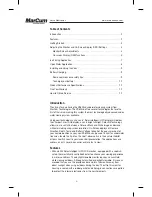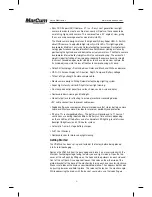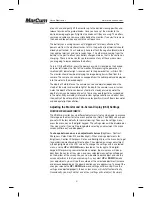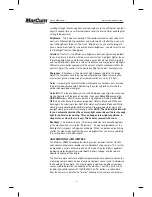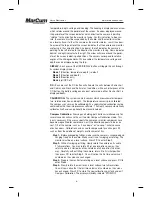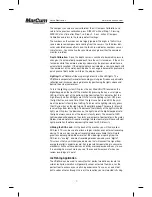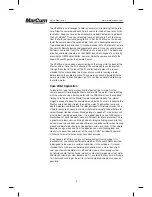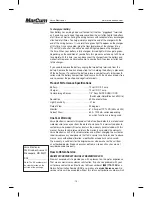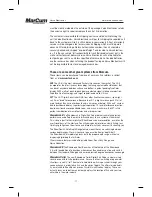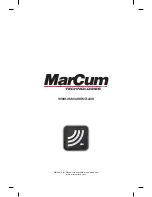
Versa Electronics
www.marcumtech.com
- 5 -
scrolling through the menu options and coming back to the setting that wouldn’t
adjust a second time, you will automatically reset the internal timer, enabling that
setting to be adjusted.
Brightness - This increases how bright the individual pixels on your screen will
illuminate. Different lighting conditions and water clarity will affect how you may
want the brightness to be set. Too much “Brightness” can cause the image to
have a washed-out look. To increase the overall brightness, you may want to use
the “Backlight” feature. [See below]
Contrast - Contrast is the difference in brightness between lightest and darkest
tones in a picture. A picture with too much contrast has highlights (lighter tones)
that are too bright and no detail and shadow areas that are too black. A picture
with too little contrast looks dull, with no true blacks and more grayish highlights.
Different water clarities coupled with the amount of light available will affect the
contrast. Adjust the contrast to the desired setting for the best overall picture.
Sharpness - Sharpness is the amount of high-frequency detail in the image.
Adjust the sharpness according to personal preference. (Note: increasing the
contrast can give an impression of increased sharpness, so try this first).
Color - Increasing the color saturation will increase the vividness but can make
the picture look darker overall. Decreasing the color saturation will make the
colors look washed out and gray.
Color-Kill – This feature allows you to switch between super high-res color, and
black and white with the push of a button. To access
Color Kill, pressing the
UP/DOWN arrows after this menu option is highlighted, will select either ON/
OFF, which will chance the display image from Color to Black and White and
back again. For viewing in low-light, dirty water, or after dark, Black and White
viewing is recommended for optimal viewing. Clear or good water clarity and
daylight viewing is optimal for viewing in color.
NOTE: The Color-kill feature will
turn on automatically when the camera’s light sensor doesn’t detect enough
light for optimal color viewing. This can happen in low light conditions, in
deep water, or when the ice is very thick and/or covered with snow.
Backlight – This enables the user to increase or decrease to overall brightness
of the monitor without using the “Brightness”. As a general guideline, set the
Backlight at its highest setting when outdoors. When in a darkened ice fishing
shelter, the highest Backlight setting may be brighter than necessary, so dialing
this setting back may be desirable.
ON-SCREEN DISPLAY (OSD) FUNCTIONS
The MarCum VS625sd underwater viewing system includes the most techni-
cally advanced features available in an underwater fishing camera. This system
incorporates a variety of sensors and an On Screen Display (OSD), capable of
displaying water temperature, water depth, battery voltage, and the relative
direction heading of the camera.
The Manta camera contains a digital temperature sensor, a pressure sensor for
measuring camera depth, and an electronic compass sensor used to determine
the heading of the camera. The monitor base includes an additional compass
sensor used to determine the heading of the monitor. The OSD circuit, which
includes the control panel with the DISPLAY and F/C buttons, receives data
from the camera, calculates the “relative” heading of the camera, and displays


